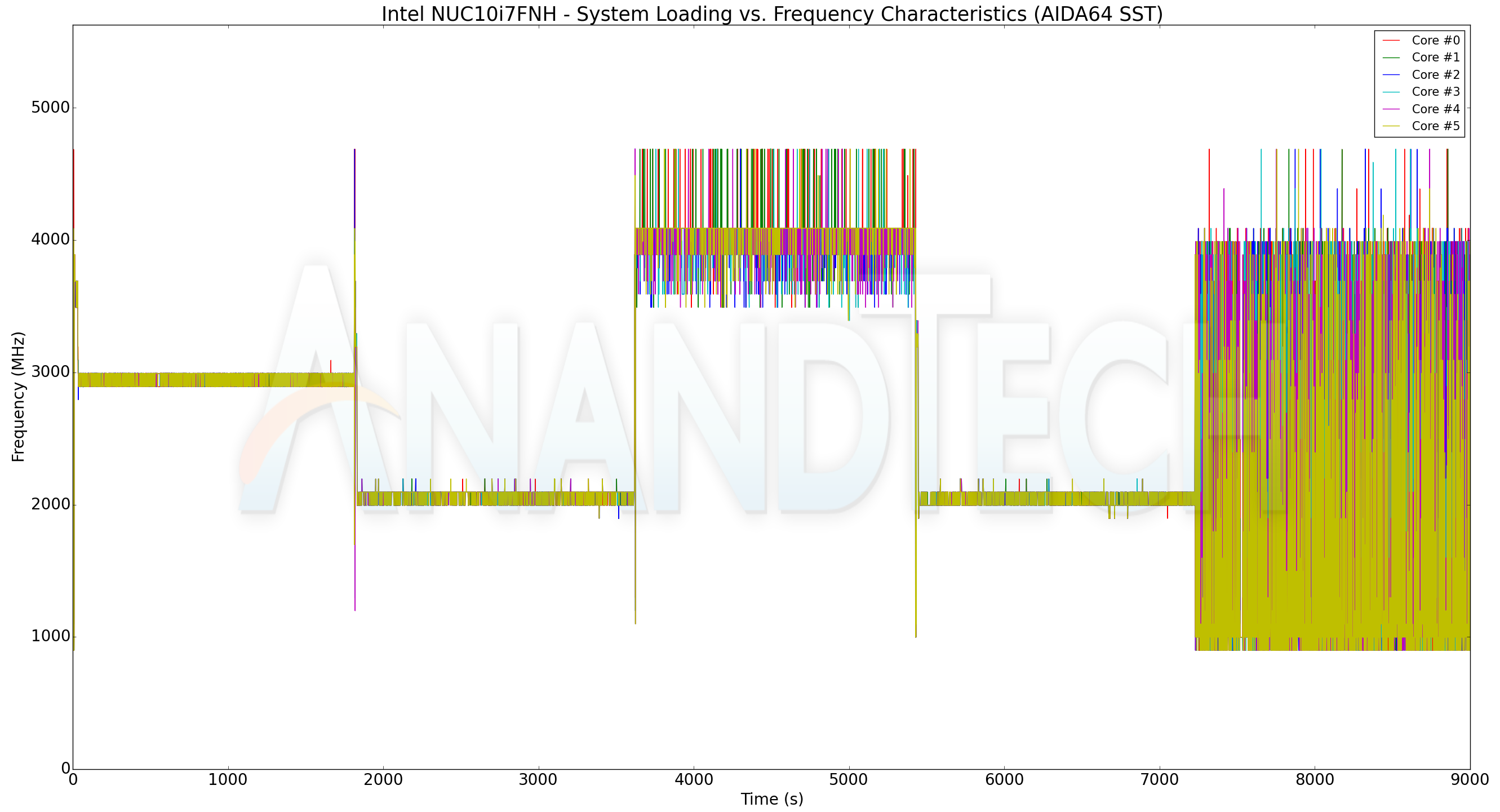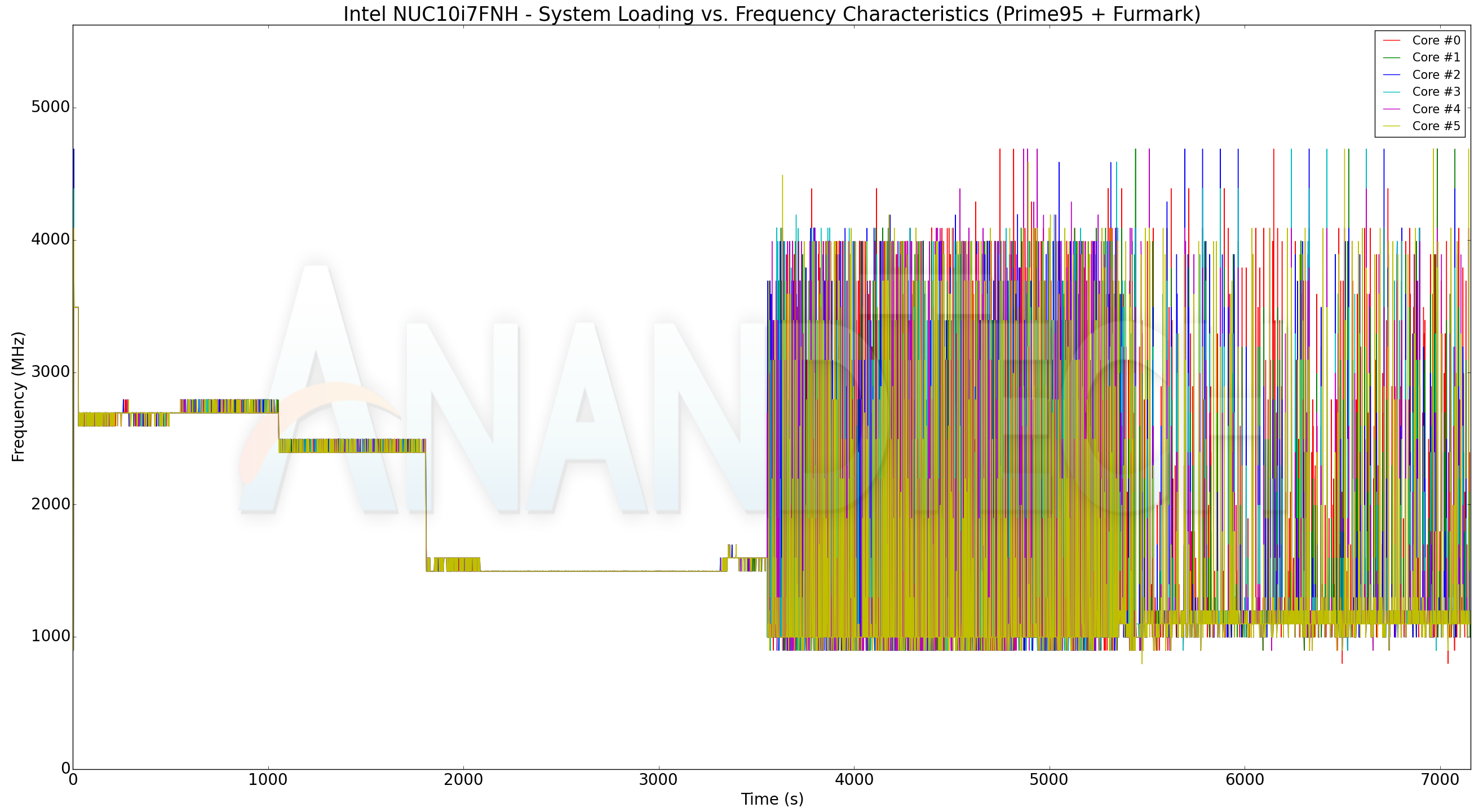Intel NUC10i7FNH Frost Canyon Review: Hexa-Core NUC Delivers a Mixed Bag
by Ganesh T S on March 2, 2020 9:00 AM ESTPower Consumption and Thermal Performance
The power consumption at the wall was measured with a 4K display being driven through the HDMI port. In the graphs below, we compare the idle and load power of the Intel NUC10i7FNH (Frost Canyon) with other low power PCs evaluated before. For load power consumption, we ran the AIDA64 System Stability Test with various stress components, and noted the maximum sustained power consumption at the wall.

The usage of a PCIe 3.0 x2 NVMe SSD along with a low TDP processor (25W, compared to the 28W+ processors in the other systems, other than the June Canyon NUC) manufactured in a highly-optimized and power-efficient 14nm process result in the Frost Canyon NUC having a sub-5W idle power consumption even while driving a 4K display. The system is able to sustain 90W+ at the wall for a very brief duration only, with the power falling slightly south of 60W for sustained workloads.
Our thermal stress routine starts with the system at idle, followed by four stages of different system loading profiles using the AIDA64 System Stability Test (each of 30 minutes duration). In the first stage, we stress the CPU, caches and RAM. In the second stage, we add the GPU to the above list. In the third stage, we stress the GPU standalone. In the final stage, we stress all the system components (including the disks). Beyond this, we leave the unit idle in order to determine how quickly the various temperatures in the system can come back to normal idling range. The various clocks, temperatures and power consumption numbers for the system during the above routine are presented in the graphs below.
| Intel NUC10i7FNH (Frost Canyon) System Loading with the AIDA64 System Stability Test | |||

The frequencies adjust to ensure that the 30W PL1 is maintained. With just the CPU loaded, the cores can maintain around 3 GHz sustained. Adding the GPU brings the CPU cores down to 2 GHz. With only the GPU stressed, the CPU cores can stay close to their boost clocks without consuming much power. The thermal design is quite good, with the package temperature never above 90C for extended durations.
| Intel NUC10i7FNH (Frost Canyon) System Loading with Prime95 and Furmark | |||

Our custom stress test with Prime95 and Furmark shows similar characteristics. Frequencies get adjusted to maintain a 30W package power, and the package temperature does not cross 85C. Furmark loads the GPU more than the AIDA stress component, and hence, we see the CPU frequency drop down to around 1.5 GHz in this case.










85 Comments
View All Comments
YB1064 - Monday, March 2, 2020 - link
In the temperature charts (thermal performance page), the green graph shows huge temperature spikes (~ 20 C, Furmark). Is this real? The package graph is less noisy. How are you measuring this?ganeshts - Monday, March 2, 2020 - link
All parameters are recorded using HWiNFO. We have been using the program since 2013 for recording the sensor values in all our SFF PC reviews.abqnm - Monday, March 2, 2020 - link
"A new set of value-added features include the ability to configure a RAM disk in the BIOS, mount iSCSI volumes prior to boot, and set up various network interface characteristics."These are all actually possible in the NUC8 visual bios too, though the settings are a lot harder to find, buried in the boot tab.
Ratman6161 - Monday, March 2, 2020 - link
This system isn't making a lot of sense to me from a price/performance standpoint. $605 for a bare bones? $940 as configured? Yikes!.One of the things I noticed is that there were a lot of benchmarks where the Asrock mini with the i3-8100 did pretty well against the i7 "u" cpu's. Particularly for just a standard office sort of machine, which is what I have
in mind, the i3 performs just about as well and definitely well into the more than good enough range. Of course the i3-8100 will use more juice but its also way cheaper. I just had to satisfy my curiosity so I priced out a system. The Asrock mini with an i3-9100 (vs the 8100 in the review), 16 GB DDR4, 500 GB Samsung 970 Evo (previous gen without the + to save a few bucks) and a Noctua low profile cooler for a grand total of $465.00. I've got plenty of decommissioned 2.5 inch disk drives if I need to expand. Or if I want to cheap out completely, I could use an old 2.5 inch 850 EVO 256 GB I've got laying around which would bring the price down to $375.00.
If I really wanted more CPU power, the mini would actually take an i7-9700K which would be +$275 from my local Microcenter and take the $465 configuration up to $740...still $200 under the NUC. Or a more reasonable for this system i5-9400 would add just +$65 to $530 total.
So, keeping in mind that graphics don't matter for my usage and neither does the power savings of the "U" cpu's, I just can't see the reviewed system as a viable option
Holliday75 - Monday, March 2, 2020 - link
I need 10k of them to install at buildings across the country. How soon can you build these and deliver?Holliday75 - Monday, March 2, 2020 - link
EDIT: Oh and I need ongoing hardware and kernel level support for the next 5 years with an option to extend that to 7 if needed. We boot a custom Linux image via PXE and this image changes on a regular basis along with our network infrastructure that serves it.PeachNCream - Monday, March 2, 2020 - link
I get teh point you are making, but there are also other mass-produced options other than NUC systems. Yes they are sometimes physically larger, but a SFF Dell or HP box may cost somewhat less in a bulk buy than a NUC with comparable compute power. If you need 10k fixed location systems, that would be where I would turn first rather than NUCs and certainly not use DIY builds.sandtitz - Monday, March 2, 2020 - link
That'll take about 3-4 months since Intel can't provide the CPUs...Ratman6161 - Tuesday, March 3, 2020 - link
"I need 10k of them to install at buildings across the country. "So? You have a different need than me. I just need one :). If you need them mass produced all the major manufacturers build something that's in this general size range with many different options for CPU, RAM, storage etc.
But my main point still holds. There are options for PC's that are both cheaper and more powerful than the NUC.
Irata - Monday, March 2, 2020 - link
You guys are still using Bapco benchmarks? Really?